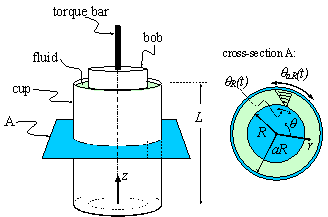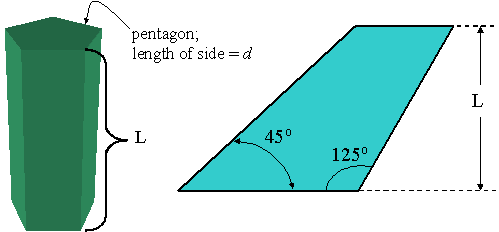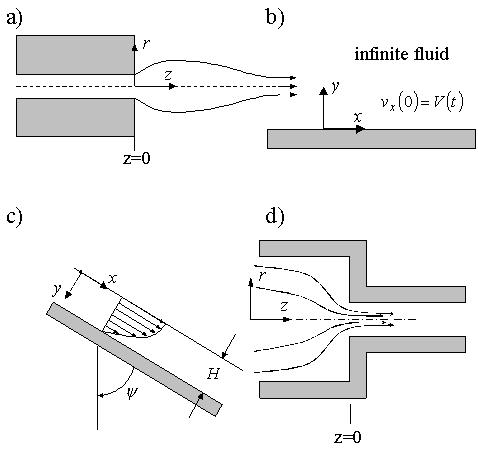| Return
to CM3110 Home Page |
Review questions
CM3110 Fall 2006 Dr.
Faith Morrison
October 26, 2006
- When we wish to solve for a velocity profile in a flow, what
balances
will we employ?
- Why are there three components to the microscopic momentum
balance?
- When we choose a control volume for performing a microscopic
balance,
which
direction(s) must be chosen to be small, i.e. of differential length?
- When we write the stress as t21,
what is the direction of the flux? what is the direction of the
momentum?
- Indicate the direction of the flux of momentum on the following
drawings
(the direction of the flux, not the direction of the momentum):



- What is a Venturi meter? What is an orifice meter?
- What is Reynolds number? Where does it come from
- What is Fanning friction factor? Where did we derive it from?
- What is the frictional loss as a function of flow rate, Q, in a
piping
system that has 21 ft of straight pipe, two 90o elbows and a
gate valve?

- What is the pressure at the bottom of each of the tanks shown
above?
Write
your answer in terms of the variables and values given.
- Referring to the figure below, derive an equation that relates P1
to the variables listed for the manometer shown. Also, is rA
larger or smaller than rf? How
do
you know?

- What is the point of designing a manometer to have a large well
on one
or both sides? (see figure above in last problem)
- Calculate the velocity profile for the laminar flow of two layers
of
Newtonian
fluid (see figure below). The bottom fluid has viscosity m1,
and the top fluid has viscosity m2;
both fluids are incompressible, and the flow is at steady state. The
flow
is driven by the motion of the top wall which moves at velocity V.

- What is shear rate?
- How is the viscosity different for a Newtonian fluid and a
non-Newtonian
fluid?
- Does Newton's Law of Viscosity apply to a non-Newtonian fluid?
- What is a power-law fluid? What is a Bingham plastic or Bingham
fluid?
- Calculate the velocity profile for the flow of a power-law,
generalized
Newtonian fluid down an inclined plane. The geometry and flow
conditions
are the same as the example we did in class except that the fluid is
not
Newtonian but rather is a power-law, non-Newtonian fluid.
- Give an example of a non-Newtonian fluid.
- You have a Newtonian fluid and a non-Newtonian fluid that have
the same
viscosities at low shear rates. Which will be easier to stir at high
rates?
Why?
- What is yield stress?
- What are the units of viscosity?
- What is the defining equation of viscosity?
- What is the vector force on a vertical wall when a jet of water
flowing
at 25m/s impinges on the wall? Assume that the stream splits in two
streams
that follow the wall, one going up and the other going down.
- The mechanical energy balance is given below. What type of energy
is associated
with each term of the mechanical energy balance?

- What type of momentum transfer is associated with each term of
the
macroscopic
momentum balance?
- Why is the macroscopic momentum balance a vector equation? Why is
the
mechanical
energy balance a scalar equation?
- What is a vector? What is a scalar?
- What is a coordinate system?
- The Navier-Stokes (microscopic momentum balance for Newtonian
fluids)
equation
has three components. What balance does each of the components of the
Navier-Stokes
equation represent individually?
- The equation of motion was given to you in two different forms
(think
of
the handout with the components of the equation of motion). When would
you use the version with stresses in it (on the front of the handout)
and
when would you use the Navier-Stokes version (on the back of the
handout)?
- What is the equation of continuity? What balance does it
represent?
- I want to calculate the force on a 70o elbow when
fluid is
flowing
in it. What balance will I need to apply?
- What is the meaning of the parameter alpha
that
appears in the mechanical energy balance?
- What is the meaning of the parameter beta
that
appears in the macroscopic momentum balance?

- For pressure-driven flow in a tube (Poiseuille flow), the
velocity
profile
of a fluid is observed to be as shown in the figure above.
Is the fluid Newtonian or non-Newtonian?
- What is an open system? What is a closed system?
- What is stress? What is momentum flux? How are they related?
- What is the point of non-dimensionalization?
- What is scale-up?
- Where does the mechanical energy balance come from?
- What is the difference between the microscopic momentum balances
and
the
macroscopic momentum balance?
- What is Froude number? Where does it come from?
- Write down the boundary conditions for the following flows:

- If a sphere falls at a terminal velocity of 0.001m/s in water at
room temperature, what is the drag force on the sphere?
- The pressure drop across a packed bed of void fraction 0.45 is 12
psi. The bed is 1m long. What is the flow rate in the bed?
- What is the Ergun equation?
- An oil flows in a pipe of diameter 1" at 1 gal/min. What is
the pressure drop across the pipe?
- Two pipes are connected in series. The first is 1" in
diameter and 40ft long, and the second is 0.5 " in diameter and 100ft
long. The upstream pressure is 60psig. What is the flow
rate through the device? (requires iteration)
- What is void fraction?
- If the velocity field in a flow of a power-law fluid is v_1=65
x_2 mm/s, v_2=0, v3_0, what is the shear stress in this flow? You
may leave the parameters m and n in your final answer.
- What is form drag? (flow on a sphere)
- Calculate the velocity profile for steady pressure-driven flow of
an incompressible power-law fluid in a tube.
- Calculate the velocity profile for steady pressure-driven flow of
an incompressible power-law fluid in a wide slit.
- Calculate the velocity profile for steady pressure-driven flow of
an incompressible Newtonian fluid in a slit.
- Calculate the velocity profile for steady pressure-driven flow of
an incompressible Newtonian fluid in a slit that is tilted 45 degrees
upward.
- Calculate the velocity profile for steady gravity-driven flow of
an incompressible Newtonian fluid in a slit, i.e. the slit points
downward.
| Return
to CM3110 Home Page |
![]()






![]()

